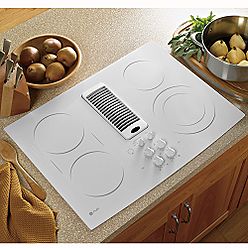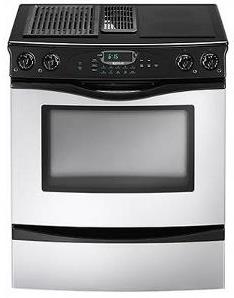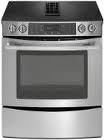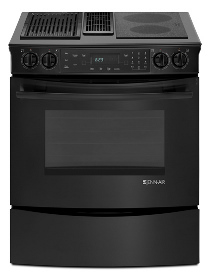 
 
Downdraft Oven
Ovens also make use of downdraft range technology for flexible kitchen design.
A downdraft oven fills the need when it is not possible to locate an oven where it is
easily connected to an overhead vent exhaust or wall vent system and in situations like this, downdraft systems can
be used to vent the fumes and smoke just like in ranges and cooktops. Some examples of these situations are when an
oven is installed by itself in a kitchen island or a wall oven with a cooktop, whether gas, electric or dual-fuel.
The downdraft system is normally installed behind the oven, venting down into the floor structure and out the house
from there. Fans can either be installed where they can be accessible for repair in the wall, floor or outside the
house.
As mentioned, downdraft oven can come combined with a range that includes a grill or even a deep fryer or they
can be stand-alone. It is becoming popular to have a wall oven instead of a slide-in range or stand alone range but
these are usually more expensive to install. However, a wall oven with warming drawers can be a very stylish space
saver and gives a kitchen a lot more flexibility. For some people, a wall oven is a health issue because they don't
need to bend down to open the oven door and can do it standing up if the oven is installed at the right height.
Electric vs Gas ovens
Strangely enough, even though electric convection ovens have regulators that maintain a more precise temperature
and baking environment, gas ovens that cook more unevenly are far more popular with professionals who actually
prefer the results. This is because of the instant on-off and precise heat controls that gas provides while
electric oven temperatures rise and lower gradually. Gas ovens have regulator valves that switch the oven on or off
within a temperature range while electric convection oven have a much more precise and stable baking and roasting
environment. Convection cooking is needed to bake or roast evenly and most purists will contend that there is no
such thing as a "gas convection" oven because they use fans to circulate the hot air and mimic convection cooking.
In gas ovens, the burners are usually under the lower plate and the fans are towards the back so they don't affect
the gas flames in any way. Nevertheless, it is common to have a dual-fuel combination to get the best of both
worlds--gas for quick heating and cooling and electric for true convection cooking. A good downdraft ventilation is
a must for gas and dual fuel downdraft ovens however because they can produce carbon monoxide. With today's modern
and open kitchens, the downdraft oven is a practical and attractive fixture.

| 



